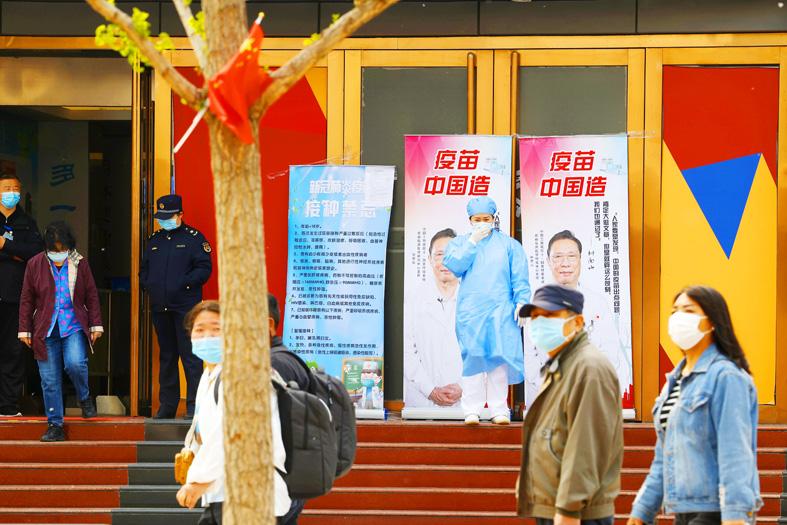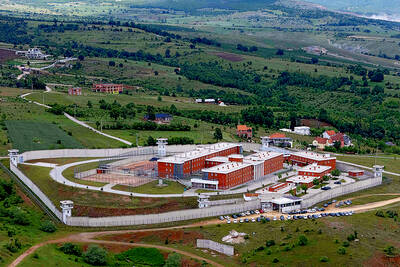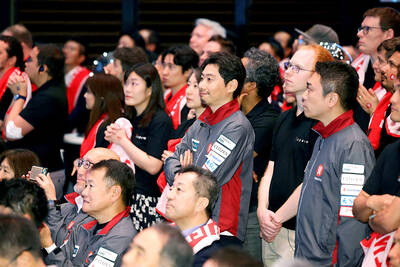China is considering mixing different COVID-19 vaccines to improve the relatively low efficacy of its existing options, a top health expert told a conference in Chengdu on Saturday.
Authorities have to “consider ways to solve the issue that efficacy rates of existing vaccines are not high,” Chinese media outlet The Paper reported, citing Chinese Center for Disease Control and Prevention Director Gao Fu (高福).
His comments mark the first time a top Chinese expert has publicly alluded to the relatively low efficacy of the country’s vaccines, as China forges ahead in its mass vaccination campaign and exports its jabs around the world.

Photo: AP
China has administered about 161 million doses since vaccinations began last year — most people require two shots — and aims to fully inoculate 40 percent of its 1.4 billion population by June.
Many have been slow to sign up for jabs, with life largely back to normal within China’s borders and domestic outbreaks under control.
Gao has said that the best way to prevent the spread of COVID-19 is vaccination, and said in a state media interview that China aims to vaccinate 70 to 80 percent of its population between the end of this year and the middle of next year.
An option to overcome the efficacy problem is to alternate the use of vaccine doses that tap different technologies, Gao said at the conference.
This is an option that health experts outside China are studying as well.
Experts should not dismiss the use of messenger ribonucleic acid (mRNA) vaccines just because there are already several coronavirus jabs in the country, The Paper cited Gao as saying.
None of China’s jabs conditionally approved for the market are mRNA vaccines, but products that use the technology include those by US pharma giant Pfizer and German start-up BioNTech, as well as by Moderna.
China has four conditionally approved vaccines, whose published efficacy rates remain behind rival jabs by Pfizer-BioNTech and Moderna, which have 95 percent and 94 percent rates respectively. China’s Sinovac previously said trials in Brazil showed around 50 percent efficacy in preventing infection and 80 percent efficacy in preventing cases requiring medical intervention.
Sinopharm’s vaccines have efficacy rates of 79.34 percent and 72.51 percent respectively, while the overall efficacy for CanSino’s stands at 65.28 percent after 28 days.

By 2027, Denmark would relocate its foreign convicts to a prison in Kosovo under a 200-million-euro (US$228.6 million) agreement that has raised concerns among non-governmental organizations (NGOs) and residents, but which could serve as a model for the rest of the EU. The agreement, reached in 2022 and ratified by Kosovar lawmakers last year, provides for the reception of up to 300 foreign prisoners sentenced in Denmark. They must not have been convicted of terrorism or war crimes, or have a mental condition or terminal disease. Once their sentence is completed in Kosovan, they would be deported to their home country. In

Brazil, the world’s largest Roman Catholic country, saw its Catholic population decline further in 2022, while evangelical Christians and those with no religion continued to rise, census data released on Friday by the Brazilian Institute of Geography and Statistics (IBGE) showed. The census indicated that Brazil had 100.2 million Roman Catholics in 2022, accounting for 56.7 percent of the population, down from 65.1 percent or 105.4 million recorded in the 2010 census. Meanwhile, the share of evangelical Christians rose to 26.9 percent last year, up from 21.6 percent in 2010, adding 12 million followers to reach 47.4 million — the highest figure

A Chinese scientist was arrested while arriving in the US at Detroit airport, the second case in days involving the alleged smuggling of biological material, authorities said on Monday. The scientist is accused of shipping biological material months ago to staff at a laboratory at the University of Michigan. The FBI, in a court filing, described it as material related to certain worms and requires a government permit. “The guidelines for importing biological materials into the US for research purposes are stringent, but clear, and actions like this undermine the legitimate work of other visiting scholars,” said John Nowak, who leads field

LOST CONTACT: The mission carried payloads from Japan, the US and Taiwan’s National Central University, including a deep space radiation probe, ispace said Japanese company ispace said its uncrewed moon lander likely crashed onto the moon’s surface during its lunar touchdown attempt yesterday, marking another failure two years after its unsuccessful inaugural mission. Tokyo-based ispace had hoped to join US firms Intuitive Machines and Firefly Aerospace as companies that have accomplished commercial landings amid a global race for the moon, which includes state-run missions from China and India. A successful mission would have made ispace the first company outside the US to achieve a moon landing. Resilience, ispace’s second lunar lander, could not decelerate fast enough as it approached the moon, and the company has